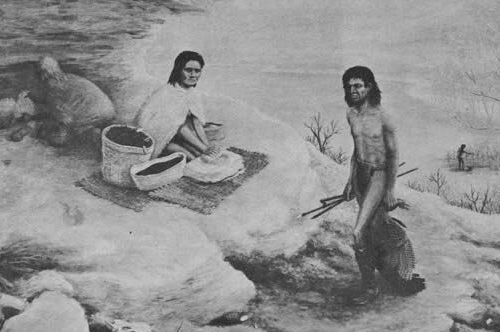Our History
-
Our History
Bluff Dwellers Cave is a rare gem lost in the Ozark region of Missouri. A bat’s flight from both Arkansas and Oklahoma, the cave has been attracting guests from across the U.S. for decades. Arthur Browning discovered, explored, and eventually opened Bluff Dwellers Cave to the public in 1927.

-
Our Prehistory
Arthur Browning was not the first man to step foot in the cave, ancient Archaic-aged Native Americans used the cave and others in the Ozark region as shelter. These ancient people were known as “Bluff Dwellers” by many of the early archaeologists of the area, and thus the name of Bluff Dwellers Cave was born.

Our Prehistory
Native Americans from the Archaic, beginning about 8500 B.C., lived in small family groups. They were known as Bluff Dwellers because they often sheltered in caves or under bluffs by streams. They were gradually shifting from a nomadic lifestyle to one more settled as they learned the art of agriculture. They gathered greens, seeds, fruits, nuts, roots, and mushrooms. They hunted eggs, insects, small animals, and fish, as well as big game. These were the people who originally explored Bluff Dwellers Cave thousands of years prior to Arthur Browning’s discovery in 1925. During the excavation at Bluff Dwellers Cave it was discovered that the cave was sealed shut from a landslide about 2000-3000 years ago. Artifacts from Archaic Native American culture were found in the landslide debris, indicating that prior to the landslide the cave was used as occasional shelter and storage. Among the artifacts found in Bluff Dwellers Cave were grinding stones, arrowheads, a bed of ashes and a few skeletal remains.
The recognition and naming of the “Ozark Bluff-Dwellers Culture” was first attributed to Mark Harrington, a representative of The Museum of The American Indian, Heye Foundation,. New York. In the early twenties Mr. Harrington, with a crew from the museum, and often assisted by local residents, conducted a series of trial explorations in the Ozarks. He subsequently centered most of his activity in Benton and Carroll Counties of Northwest Arkansas, where several dry shelters were found with the aid of native guides. Materials salvaged from these shelters, especially the Bushwhack site, were in a good state of preservation.
Later archaeological work was accomplished in the general Bluff Dweller area of northwest Arkansas, northeast Oklahoma, and southwest Missouri by field crews from the state universities. A note of urgency was injected into the archaeological picture when plans were announced for the building of Table Rock Dam, which would put valuable archaeological sites under water. Quick action preceding the construction of the big dams resulted in significant discoveris of artifacts by the University of Missouri in the Table Rock basin; and by the University of Arkansas to the south.
Our History
Limestone rock, in which most Ozark caves are formed, covers much of the Ozark Plateau in the Midwest. In 1925 C. Arthur Browning was checking traps on property his family had owned his whole life when he came across a cool breeze blowing from a limestone outcrop. It was here that Bluff Dwellers Cave was discovered by Mr. Browning when he brought back help. Bob Ford and Bryan Gilmore, employed by the highway department, helped Arthur Browning move loose rock and debris so that he could explore.
Excavation began from a small basketball-sized opening. It was amazing to find a cave so large and intricate on land that Mr. Browning- now in his 40s-had lived his entire life! Two natural openings were found that had been hidden by a landslide that had occured over 2000 years ago. From the outside you would have never guessed a cave to be there until they began moving the large slabs of limestone.
Two years later, in 1927, Bluff Dwellers Cave was opened to the public for tours. The cave is still owned by the family- currently owned and operated by the grandchildren of Arthur Browning.

